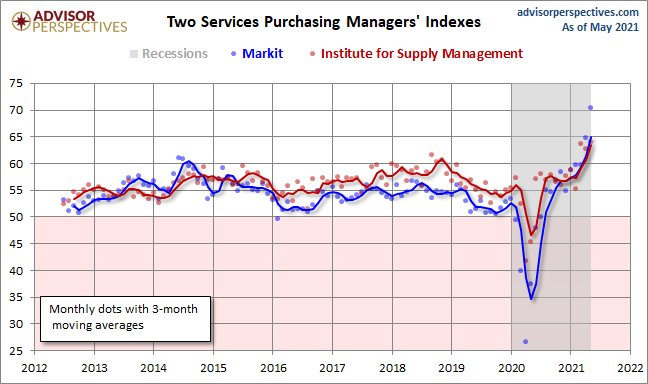March Markit Services PMI: "Business Activity Growth Rate Accelerates To Record High In May"
The May US Services Purchasing Managers' Index conducted by Markit came in at 70.4 percent, up 5.7 from the final April estimate of 64.7 and a record high.
Here is the opening from the latest press release:
Commenting on the latest survey results, Chris Williamson, Chief Business Economist at IHS Markit, said:
“The US economic recovery shifted up a gear in May, with output of the combined manufacturing and service sectors surging past all prior peaks by an impressive margin. The strong correlation between the PMI and GDP means the economy looks set to enjoy rapid – potentially double-digit – growth in the second quarter.
“Further robust expansions are indicated for the summer months, with an improving order book situation accompanied by elevated levels of business confidence and the further easing of virus restrictions both at home and abroad. But the survey’s price gauges have also climbed to unsurpassed levels, which will add to inflation worries. These unprecedented output and price growth rates will inevitably lead to speculation about an earlier than previously expected tapering of Fed policy.” [Press Release]
Here is a snapshot of the series since mid-2012.

Here is an overlay with the equivalent PMI survey conducted by the Institute for Supply Management, which they refer to as "Non-Manufacturing" (see our full article on this series here). Over its history, the ISM metric has been significantly the more volatile of the two.

The next chart uses a three-month moving average of the two rather volatile series to facilitate our understanding of the current trend. Since early in 2016, the ISM metric has shown stronger growth than the Markit counterpart.

Both series weakened since 2015 and saw an uptick in the latter half of 2016. The interim three-month moving average of the Markit Services index peaked in August of 2014. The ISM index peaked in September of 2015. The two were fairly closely aligned at the beginning of 2016, but they diverged early with the Markit index signaling noticeably weaker growth.



